|
|
|---|
| Apple II |
| Available: | June 1977 |
| Price: | US $1298 with 4K RAM |
| US $2638 with 48K RAM |
| CPU: | MOS 6502, 1.0 MHz |
| RAM: | 4K min, 48K max |
| Display: | 280 X 192, 40 X 24 text |
| 6 colors maximum |
| Ports: | composite video output |
| cassette interface |
| 8 internal expansion slots |
| Storage: | generic cassette drive |
| external 143K floppy (1978) |
| OS: | Woz Integer BASIC in ROM | |
|
|---|
|
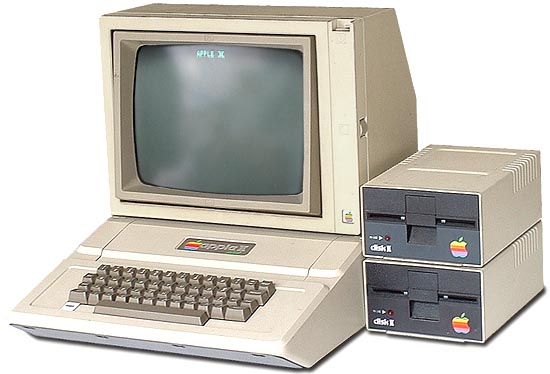
 The Apple II, or Apple ][, became one of the most popular computers ever. Although it is a vast
improvement over the Apple I, it contains the same processor and runs
at the same speed.
The Apple II, or Apple ][, became one of the most popular computers ever. Although it is a vast
improvement over the Apple I, it contains the same processor and runs
at the same speed.
New features include a color display, eight internal expansion slots, and a case with a keyboard.
That may sound funny, but the Apple I and many other early computers didn't necessarily have a case or
even a keyboard. On some systems you had to added your own keyboard, if possible, and on others you
toggled switches to enter programs and issue commands.
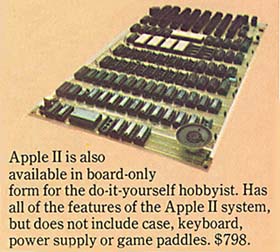 In the spirit of the original computer hacker, the Apple II was also available as a circuit-board
only, without keyboard, power supply, or case, as seen here on the right.
In the spirit of the original computer hacker, the Apple II was also available as a circuit-board
only, without keyboard, power supply, or case, as seen here on the right.
The Apple II was one of the first computer with a color display, and it has the BASIC programming language
built-in, so it is ready to run right out of the box. The Apple II was probably the first user-friendly system.
The most important feature of the Apple II was probably its eight expansion slots. No other
computer had this kind of flexability or expansion possibilities. The top of the computer isn't even attached,
it lifts off with little effort allowing easy access to the system motherboard and expansion slots.
Dozens of different expansion cards were made by Apple and other manufacturers to add to the Apple II's capabilities.
These include - memory expansion, floppy disk controllers, PASCAL and CP/M emulator cards, parallel, serial, and SCSI cards,
processor accelerators, video cards.
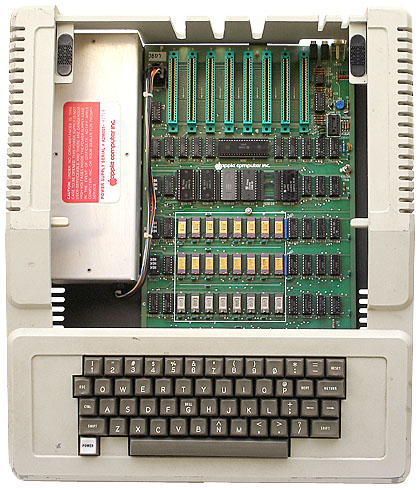
But what made sales of the Apple II take-off was the new spreadsheet program
VisiCalc. If you're familiar with Microsoft Excel,
then you know what a spreadsheet program does. It adds columns and rows of data and instantly gives
you the results. This was the first affordable program to perform such an amazing feat, something which
corporate accountants previously spent hours laboriously calculating by hand.
VisiCalc transformed the Apple II into a serious business machine. It was apparently released
on the Apple II before any other system due to Apple's rather large memory size, since the Apple II
could support up to 48K of RAM.
VisiCalc was the first so-called Killer App
- many businesses bought the Apple II computer for the sole purpose of running VisiCalc.
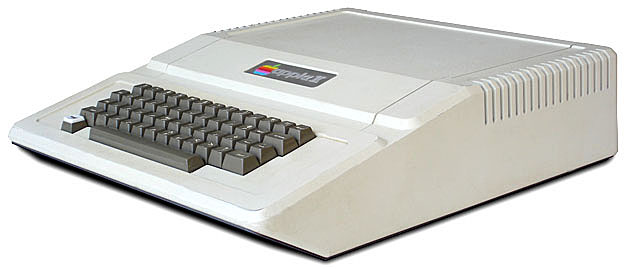
The Apple II was followed by:
1979 - Apple II Plus
1983 - Apple IIe
Both of which are similar to the Apple II, but with many new features and upgrades built-in.
One version of the IIe had a numeric keypad built into the right side of the keyboard.
Apple continued to produce and sell Apple IIe's up until 1993, extending the life of the Apple II
series past 15 years!
One month after the Apple II was released, BYTE magazine published an article
about the Apple II computer. This article was written by the creator of the Apple II computer,
Steve Wozniak.
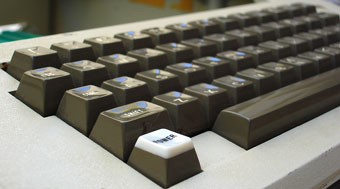
| Apple II Price List (June 1977) |
RAM
Complement | Apple II
System | Apple II
Board Only |
| 4K | $ 1,298.00 | $ 598.00 |
| 8K | 1,398.00 | 698.00 |
| 12K | 1,498.00 | 798.00 |
| 16K | 1,698.00 | 978.00 |
| 20K | 1,778.00 | 1,078.00 |
| 24K | 1,878.00 | 1,178.00 |
| 32K | 2,158.00 | 1,458.00 |
| 36K | 2,258.00 | 1,558.00 |
| 48K | 2,638.00 | 1,938.00 |
|
|---|
History of the Apple Computer Corporation |
- 1973: Stephen Wozniak joins HP.
- 1976: Wozniak proposes that HP create a personal computer. He is rejected.
- 1976: March - Steve Wozniak and Steve Jobs finish work on a computer circuit board, that they call
the Apple I computer.
- 1976: April - Steve Jobs and Steve Wozniak form the Apple Computer Company, on April Fool's Day.
- 1976: July - The Apple I computer board is sold in kit form, and delivered to stores by Steve Jobs
and Steve Wozniak. Price: US$666.66.
- 1976: August - Steve Wozniak begins work on the Apple II.
- 1976: October - Wozniak remains at HP, but is soon convinced that he should leave and join Apple Computer.
- 1976: December - Steve Wozniak and Randy Wigginton demonstrate the first prototype Apple II at a
Homebrew Computer Club meeting.
- 1977: March - Apple Computer moves from Jobs' garage to an office in Cupertino.
- 1977: April - Apple Computer delivers its first Apple II system, for $1295.
- 1977: May - 10 months after its introduction, 175 Apple I kits have sold.
- 1978: Apple Computer begins work on an enhanced Apple II with custom chips, code-named Annie.
- 1978: Apple Computer begins work on a supercomputer with a bit-sliced architecture, code-named Lisa.
- 1979: June - Apple Computer introduces the Apple II Plus, with 48KB memory, for US$1195.
- 1979: September - Apple Computer sells 35,000 Apple II computers for the fiscal year.
- 1979: October - 2.5 years after the introduction of the Apple II, 50,000 units have been sold.
- 1979: Apple Computer begins work on "Sara", the code name for what will be the Apple III.
- 1980: May - Apple Computer introduces the Apple III. Price ranges from US$4500 to US$8000.
- 1980: September - Apple Computer sells over 78,000 Apple II computers during the fiscal year.
- 1980: Apple Computer ships the first Apple III units in limited quantity.
- 1980: Apple Computer begins project "Diana", which would become the Apple IIe.
- 1981: September - Apple Computer introduces its first hard drive, the 5MB ProFile, for US$3499.
- 1981: Apple Computer officially reintroduces the Apple III, with improved software and a hard disk.
- 1982: Sales of Apple II Plus to date: 45,000.
- 1982: Sales of all Apple II systems to date: 750,000.
- 1982: Apple Computer becomes the first personal computer company to reach US$1 billion in annual sales.
- 1982: Franklin Computer Corp. unveils the Franklin Ace 1000,
the first legal (at the time) Apple II clone.
- 1983: January - Apple Computer officially unveils the Lisa computer. Its initial price is US$10,000.
During its lifetime, 100,000 units are produced.
- 1983: January - Apple Computer introduces the Apple IIe for US$1400.
- 1983: June - The one millionth Apple II is made.
- 1983: June - Apple Computer begins shipping the Lisa.
- 1983: June - Video Technology introduces the Laser 3000, an Apple II workalike microcomputer.
- 1983: June - Unitronics shows the Sonic, an Apple II workalike microcomputer.
- 1983: July - Apple Computer officially begins marketing the Lisa computer.
- 1983: December - Apple Computer introduces the redesigned Apple III as the Apple III+, for US$3000.
- 1983: December - Apple unveils the new Macintosh to the press.
- 1983: Franklin shows an operating Franklin Ace 1200 Apple II compatible for US$2200.
- 1984: January - Apple releases a new version of the Lisa computer, the Lisa 2. It uses all new software,
as well as the Macintosh operating system.
- 1984: January - Apple Computer's Steve Jobs introduces the Apple Macintosh.
- 1984: April - Apple Computer unveils the
Apple IIc, priced at US$1300.
- 1984: April - Apple Computer retires the Apple III and Apple III+, with only 65,000 units sold in total (90,000 made).
- 1984: May - Apple Computer announces that 70,000 Macintosh computers have been shipped in the first 100 days since
its announcement.
- 1984: September - Apple Computer introduces the Macintosh 512K for US$3200.
- 1984: November - The 2 millionth Apple II computer is sold.
- 1984: Apple sells the 250,000th Macintosh system.
- 1985: January - Apple Computer officially renames the Lisa the Macintosh XL.
- 1985: March - Apple Computer introduces the Apple Enhanced IIe.
- 1985: April - The Macintosh XL (formerly called Lisa) is dropped from Apple Computer's product line.
- 1986: January - Apple Computer introduces the Macintosh Plus. Price is US$2600.
- 1986: April - Apple Computer discontinues the original Macintosh and the Macintosh 512K.
- 1986: April - Apple Computer introduces the Macintosh 512K Enhanced, for US$2000.
- 1986: July - Apple Computer discontinues the Macintosh XL.
- 1986: September - Apple Computer introduces the Apple IIGS, with the Apple 3.5 drive, for US$1000.
- 1987: January - Apple Computer introduces the Apple Platinum IIe.
- 1987: March - Apple Computer introduces the open architecture Macintosh II, US$3900.
- 1987: March - Apple Computer makes its 1 millionth Macintosh personal computer.
- 1987: March - Apple Computer introduces the expandable Macintosh SE for US$2900.
- 1987: March - Apple Computer discontinues the Macintosh 512K Enhanced.
- 1987: Apple Computer begins shipping the Macintosh II.
- 1988: September - Apple Computer introduces the Apple IIc Plus for US$1100.
- 1988: September - Apple Computer introduces the Macintosh IIx computer, base price is US$7770.
- 1989: January - Apple Computer introduces the Macintosh SE/30, US$6500.
- 1989: September - Apple Computer announces the Macintosh Portable,
for US$6500.
- 1989: September - Apple Computer announces the Macintosh IIci, for about US$8700.
Source:
Chronology of Events in the History of Microcomputers
| |
|---|
|
Return to the Obsolete Technology Homepage

Copyright 2024
This page last updated on 01/01/2025 01:22:25
All logos and trademarks on this site are property of their respective owner.
|

 In the spirit of the original computer hacker, the Apple II was also available as a circuit-board
only, without keyboard, power supply, or case, as seen here on the right.
In the spirit of the original computer hacker, the Apple II was also available as a circuit-board
only, without keyboard, power supply, or case, as seen here on the right.



